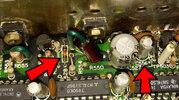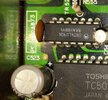I finished re-capping the main board and now I'm moving on to the frequency counter.
Its board is double sided and can apparently be a challenge to R&R the caps unless you have more than your basic solder removal tool. All I have for solder removal is your basic plunger-type, solder wick and an old Radio Shack bulb-type. I'm not sure if they are going to do the job. I haven't messed around with dual soldered components very much and even when I did, it was not easy or pretty.
The main board on my 2000 was quite fragile when I did the caps and some of the board traces did lift on me, but I was able to repair them. Obviously I don't want that to happen in the Freq. counter module. My counter seems to work fine and it doesn't look like anyone has screwed around inside of it. I've also read about a few pars to replace to make the module more reliable. I may do them while I'm in there.
Any tips from you pros ? Oh and do you really need to replace all the tantalum's? I've read arguments both ways. Some do and some don't. Most of the caps on my main board were out of tolerance (a few were WAY out) so replacing the electrolytics in the freq. module is a no-brainer. I don't know about the tantalum's though.
Its board is double sided and can apparently be a challenge to R&R the caps unless you have more than your basic solder removal tool. All I have for solder removal is your basic plunger-type, solder wick and an old Radio Shack bulb-type. I'm not sure if they are going to do the job. I haven't messed around with dual soldered components very much and even when I did, it was not easy or pretty.
The main board on my 2000 was quite fragile when I did the caps and some of the board traces did lift on me, but I was able to repair them. Obviously I don't want that to happen in the Freq. counter module. My counter seems to work fine and it doesn't look like anyone has screwed around inside of it. I've also read about a few pars to replace to make the module more reliable. I may do them while I'm in there.
Any tips from you pros ? Oh and do you really need to replace all the tantalum's? I've read arguments both ways. Some do and some don't. Most of the caps on my main board were out of tolerance (a few were WAY out) so replacing the electrolytics in the freq. module is a no-brainer. I don't know about the tantalum's though.






